The Visual Poetry of Cinematic Aesthetics
Cinematic aesthetics, the visual language of movies, is an art form in itself. Balancing narrative and aesthetics is a delicate dance that directors and cinematographers master over time. This artistry, often overlooked by casual viewers, is the soul of a film. Read below to explore the nuances of cinematic aesthetics and how they shape our movie experiences.
The Power of Color Grading
Color grading, a post-production process, is crucial in dictating a movie’s visual tone and mood. For instance, the Wachowski siblings’ “The Matrix” used a green tint to create an otherworldly, digital feel. Conversely, Wes Anderson’s films are known for their vibrant, pastel shades that enhance the whimsical nature of his storytelling.
Understanding Framing and Composition
The way characters and objects are framed within a shot can convey volumes about the narrative. For example, a technique known as the ‘Rule of Thirds’ is commonly used in filmmaking to create dynamic, balanced compositions. Stanley Kubrick’s symmetrical framing in “The Shining” amplifies the unsettling horror elements in the film.
The Artistry of Lighting
Lighting plays an integral role in creating atmosphere and highlighting subjects. Movies like “Blade Runner 2049” use high contrast and neon lights to build a futuristic, dystopian world. On the other hand, films like “The Godfather” use low-key, shadowy lighting to evoke a sense of mystery and danger.
Cinematography: The Director’s Paintbrush
The cinematographer, or director of photography, is the artist painting the scenes with light and shadow, angle and movement. Their choice of lens, camera movement, and shot composition all contribute to the film’s overall aesthetic. Emmanuel Lubezki’s long, uninterrupted shots in “Birdman” create a sense of real-time performance, enhancing the film’s theatrical theme.
Exploring Set Design and Costuming
Set design and costuming are crucial aspects of cinematic aesthetics. They help create the film’s world and define characters. From the grand, futuristic cityscapes in “Inception” to the lavish, period-appropriate attire in “The Great Gatsby”, these elements are integral to a movie’s visual storytelling.
Useful Tips and Facts:
- Movies often use color palettes to differentiate between different timelines or realities.
- Lighting can be used to highlight a character’s emotions or state of mind.
- Understanding cinematic aesthetics can enhance your movie-watching experience.
In conclusion, cinematic aesthetics is a complex, multifaceted art form that goes beyond just ‘making a movie look good.’ It involves a careful orchestration of various elements, all working together to tell a story visually. Next time you watch a movie, take a moment to appreciate the visual poetry that unfolds on the screen. A deeper understanding of cinematic aesthetics can unlock new layers of appreciation for this powerful form of art.







